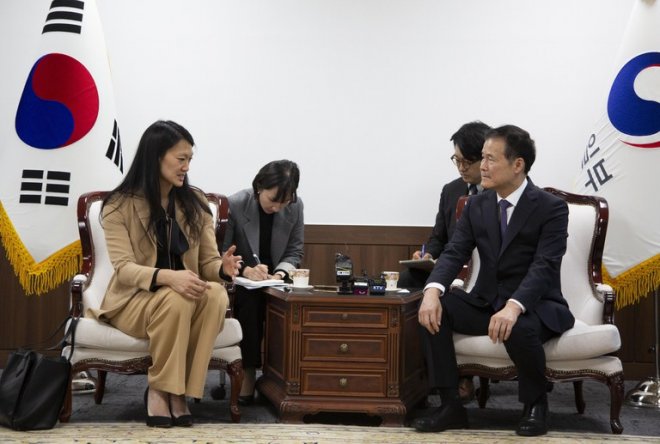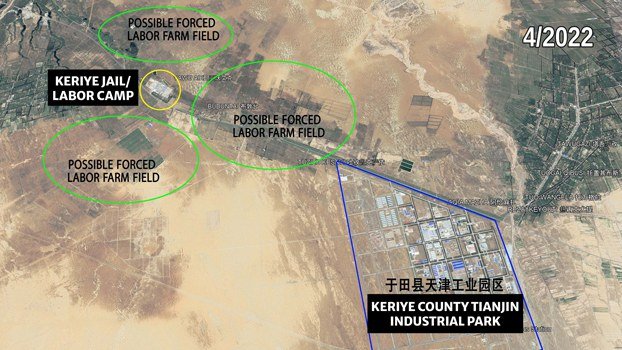US defense official: China’s maneuvers risk conflict
A rise in “dangerous maneuvers” by China’s military risks “a crisis or conflict” in the South China Sea or Taiwan Strait, the U.S. assistant secretary of defense responsible for the region said Thursday.The Pentagon has in the past two weeks released footage of two incidents of near-accidents involving Chinese vessels.
The first, from May 26, shows a Chinese jet veering suddenly in front of a U.S. reconnaissance plane over the South China Sea. The second, from June 2, shows a similar maneuver from a Chinese warship.
It’s part of a “steep rise” in “aggressive, unprofessional, risky, unsafe behavior” that has also included the release of flares and chaff – clusters of metal pieces – at U.S.-allied aircraft, said Ely Ratner, assistant secretary of defense for Indo-Pacific security affairs.
 The Chinese warship Luyang III cuts in front of the destroyer USS Chung-Hoon, as seen from the deck of the destroyer, in the Taiwan Strait, June 3, 2023.(U.S. Navy via Reuters)“It"s dangerous, it"s risky, and it tempts an incident that could lead to some kind of crisis or conflict,” Ratner said at an event at the Center for a New American Security, adding that it was made worse by a breakdown in communications between the two militaries.
The Chinese warship Luyang III cuts in front of the destroyer USS Chung-Hoon, as seen from the deck of the destroyer, in the Taiwan Strait, June 3, 2023.(U.S. Navy via Reuters)“It"s dangerous, it"s risky, and it tempts an incident that could lead to some kind of crisis or conflict,” Ratner said at an event at the Center for a New American Security, adding that it was made worse by a breakdown in communications between the two militaries.“It"s happening in the context of [China’s military] being unwilling to engage with the United States in military-to-military communications – not just crisis communications, but dialogue as well,” he said.
American defense officials have complained about their Chinese counterparts’ refusal to speak on the phone since U.S. Secretary of State Antony Blinken nixed a February trip to Beijing after an alleged Chinese spy balloon was discovered over the United States.
China’s new defense minister, Li Shangfu, also declined an invitation to meet with U.S. Defense Secretary Lloyd Austin when they were in Singapore last weekend for the annual Shangri-La Dialogue.
“We think that"s really problematic,” Ratner said.
Cold thaw
Ratner’s comments come amid strained efforts by U.S. diplomats to re-engage with China after nearly a year of rising tensions that began with then-House Speaker Nancy Pelosi’s August visit to Taiwan.
The relationship has been further strained by the spy balloon, Blinken’s canceled Beijing trip, an unofficial visit to the United States by Taiwanese President Tsai Ing-wen and U.S. efforts to cut China’s technology sector off from high-end American microchips.
Meanwhile, there has also been no shortage of warnings from U.S. generals of an imminent invasion of Taiwan by China as early as later this year, and Republican and Democratic lawmakers have seized on China policy as a rare area of bipartisan unity.
However, two senior U.S. officials were in Beijing on Monday in an attempt to pave the way for a new Blinken visit to Beijing, and there have been reports the U.S. secretary of state will make the trip within weeks. President Joe Biden has also predicted a thaw.
 Ely Ratner, Assistant Secretary of Defense for Indo-Pacific Security Affairs in Washington. (RFA Photo/Gemunu Amarasinghe)But such efforts to move toward a thaw in relations are being complicated by the rise in near-accidents between the two militaries, which Chinese officials have blamed on the U.S. side.
Ely Ratner, Assistant Secretary of Defense for Indo-Pacific Security Affairs in Washington. (RFA Photo/Gemunu Amarasinghe)But such efforts to move toward a thaw in relations are being complicated by the rise in near-accidents between the two militaries, which Chinese officials have blamed on the U.S. side.Liu Pengyu, spokesperson for the Chinese Embassy in Washington, told Radio Free Asia last month that the “provocative and dangerous moves” by American military vessels in their “close-in reconnaissance on China” was the ultimate cause of the recent near-accidents.
Ratner told the CNAS conference any suggestion that the U.S. military was even partly to blame in the incidents “makes me want to tear my hair out” given the aggressive maneuvers from China.
“We"re going to continue to fly, sail and operate safely and responsibly, in accordance with international law, as we have been doing,” he said Thursday. “This is a major problem.”
Edited by Malcolm Foster.
[圖擷取自網路,如有疑問請私訊]
|
本篇 |
不想錯過? 請追蹤FB專頁! |
| 喜歡這篇嗎?快分享吧! |
相關文章
AsianNewsCast























